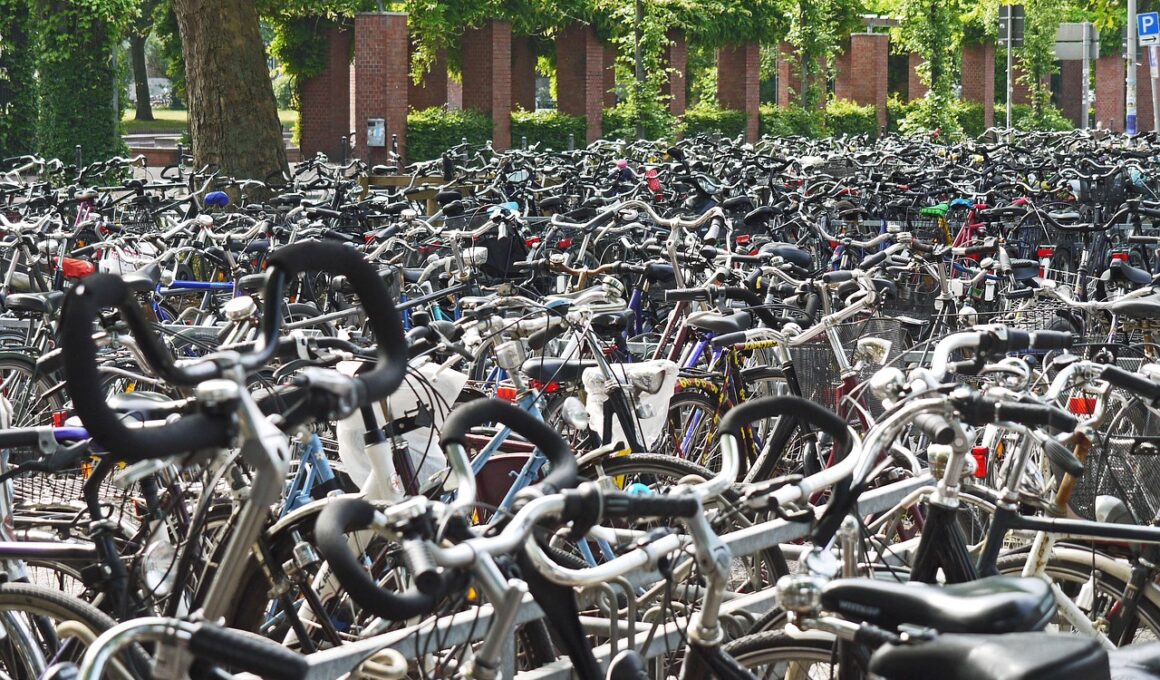The Role of Commuter Cycling in Reducing Traffic Congestion
Commuter cycling plays a crucial role in alleviating traffic congestion in urban areas. As cities continue to grow, the number of vehicles on the roads increases, leading to gridlock and frustration. When people choose to cycle instead of driving, the number of cars reduces significantly. This shift not only improves the flow of traffic but also contributes to a cleaner environment. Cycling is an eco-friendly mode of transportation, generating zero emissions and decreasing the overall carbon footprint. Moreover, cycling requires less space than cars, allowing for better utilization of roadways. Having more cyclists and fewer vehicles creates a safer environment for everyone on the road. Additionally, many cities are investing in better cycling infrastructure, including dedicated bike lanes and secure parking facilities. This infrastructure is essential to support and encourage more individuals to adopt cycling as their primary mode of commuting. As community awareness grows, the benefits of cycling are becoming more evident, influencing changes in public policy. Therefore, integrating cycling into daily commutes can significantly contribute to reducing traffic congestion and promoting a healthier lifestyle for city dwellers.
One significant advantage of commuter cycling is its cost-effectiveness for individuals and cities. For many commuters, cycling eliminates the need for fuel, parking fees, and maintenance costs associated with driving a car. Bicycles are much less expensive to purchase and maintain than cars, making them an appealing option for individuals looking to save money. Moreover, when more people choose cycling over automobile travel, cities can save on infrastructure maintenance and expansion costs. These savings can be redirected towards enhancing public transportation systems or improving bicycle paths and lanes, thereby promoting an even more favorable cycling environment. Public investments in cycling infrastructure have been shown to yield substantial returns. Enhanced cycling paths lead to increased bicycle use, which, in turn, contributes to a reduction of traffic congestion. Furthermore, cycling communities foster healthier citizens, resulting in fewer healthcare costs and lower insurance premiums for all. Local economies also benefit from more bike-friendly infrastructure as it can attract tourists and residents alike, eager to explore the vibrant urban landscape. Embracing cycling is not merely a transportation solution; it is a pathway toward more sustainable and economically viable urban living.
Environmental Benefits of Commuter Cycling
The environmental benefits of commuter cycling are profound and well-documented. Each time someone chooses to cycle instead of drive, they reduce their carbon emissions. Cars contribute significantly to greenhouse gas emissions, one of the leading causes of climate change. By opting for bicycles, individuals can lessen their environmental impact and promote a greener planet. Cycling requires fewer resources than automobile manufacturing and transportation while reducing air pollution in densely populated areas. These reductions can lead to improved public health outcomes, as cleaner air has direct positive effects on respiratory issues and overall well-being. Additionally, more bicycles on the roads can encourage biodiversity in urban areas, allowing green spaces to thrive without the pressure of heavy traffic. Cities can implement bike-sharing programs to further enhance these environmental benefits. Public bike-sharing schemes promote cycling among residents and tourists alike, contributing to the growth of a cycling-friendly culture. Furthermore, when more cities prioritize cycling as transportation, they contribute to the global effort against climate change. Each cycle ride taken is a step towards a healthier environment and more sustainable future for all.
Commuter cycling also promotes mental and physical health, which are essential aspects of an individual’s overall well-being. Regular cycling is an excellent form of exercise that supports cardiovascular health, builds strength, and improves endurance. As more commuters take to their bikes, cities may see a decrease in lifestyle-related health issues, such as obesity and diabetes. Additionally, cycling can enhance mental clarity and reduce stress levels. The act of cycling outdoors exposes individuals to nature, which can significantly improve mood and mental health. Studies have shown that physical activities, like cycling, promote the release of endorphins, commonly known as ‘feel-good hormones.’ Therefore, incorporating cycling into the daily commute can lead to healthier, happier individuals. Furthermore, traffic congestion often creates stressful environments for commuters stuck in vehicles for long periods. In contrast, cycling allows for more freedom and flexibility. Commuters can choose their routes, enjoy the scenery, and arrive at work more energized. As communities recognize the connection between health and commuting choices, cities can prioritize cycling programs and infrastructure. This prioritization will encourage more people to adopt cycling, fostering a healthier population and reducing congestion.
Challenges in Promoting Commuter Cycling
Despite its many benefits, promoting commuter cycling comes with various challenges that must be addressed. One of the most significant barriers is safety concerns. Cyclists often face dangers from drivers who may not respect bike lanes or unaware of their presence on the road. To combat this issue, cities must invest in better infrastructure, ensuring that cyclists have safe and dedicated lanes. Building protected bike lanes can reduce accidents and increase the number of people willing to cycle instead of driving. Additionally, weather conditions often deter individuals from cycling, especially in regions known for rain or snow. Cities can promote cycling year-round by providing resources and amenities like sheltered bike storage and community programs that encourage riding in inclement weather. Moreover, lack of awareness about the benefits of cycling can hinder growth in commuter cycling. Education campaigns can help inform the public about cycling’s positive impacts on health and the environment, further motivating individuals to consider bicycles as a viable commuting option. Addressing these challenges will be vital for creating a cycling-friendly community and maximizing the advantages that commuter cycling offers.
Community engagement is vital for promoting commuter cycling and ensuring its sustainability in urban areas. Ensuring that locals are involved in decision-making processes about bike infrastructure can lead to a more effective system that meets their specific needs. By conducting surveys and gathering feedback, city planners can identify key areas for improvement and develop programs that encourage cycling. Community events and festivals that celebrate cycling can also help raise awareness and educate residents about the importance of cycling for both health and the environment. Furthermore, fostering a cycling culture requires collaboration between local businesses, government, and advocacy groups. Local businesses can support cycling initiatives by providing discounts for cyclists or offering bike parking facilities. Government cooperation is essential for allocating funds and resources toward cycling infrastructure and educational programs. Advocacy groups can play an essential role in promoting cycling through community-driven initiatives and policy changes. A unified approach encourages more individuals to embrace cycling as a legitimate transportation choice. Building a supportive community fosters a sense of belonging among cyclists, which can ultimately lead to increased cycling participation and a reduction in traffic congestion.
The Future of Commuter Cycling
In conclusion, the future of commuter cycling looks bright as cities worldwide recognize its economic, environmental, and health benefits. Investment in cycling infrastructure, education, and community engagement will encourage more people to consider cycling as a primary means of commuting. Innovations in bike technology and design continue to make cycling more accessible and appealing to a broader audience. Electric bikes, for example, have gained popularity, making cycling an option even for those who prefer an easier ride. As smart cities emerge, integrating cycling into public transportation systems will facilitate a seamless commuting experience. Such integration can include bike-sharing schemes linked with buses or trains, offering complete mobility solutions. Additionally, with a growing global focus on reducing carbon emissions, government support is likely to increase for cycling initiatives, further solidifying cyclists’ roles in urban planning. Public health crises, such as pandemics, have also shown an increased interest in cycling as a safe mode of transport. Therefore, as we move forward, promoting commuter cycling can be one of the most significant steps cities can take to foster sustainable and efficient urban living.
Commuter cycling plays a crucial role in alleviating traffic congestion in urban areas. As cities continue to grow, the number of vehicles on the roads increases, leading to gridlock and frustration. When people choose to cycle instead of driving, the number of cars reduces significantly. This shift not only improves the flow of traffic but also contributes to a cleaner environment. Cycling is an eco-friendly mode of transportation, generating zero emissions and decreasing the overall carbon footprint. Moreover, cycling requires less space than cars, allowing for better utilization of roadways. Having more cyclists and fewer vehicles creates a safer environment for everyone on the road. Additionally, many cities are investing in better cycling infrastructure, including dedicated bike lanes and secure parking facilities. This infrastructure is essential to support and encourage more individuals to adopt cycling as their primary mode of commuting. As community awareness grows, the benefits of cycling are becoming more evident, influencing changes in public policy. Therefore, integrating cycling into daily commutes can significantly contribute to reducing traffic congestion and promoting a healthier lifestyle for city dwellers.


